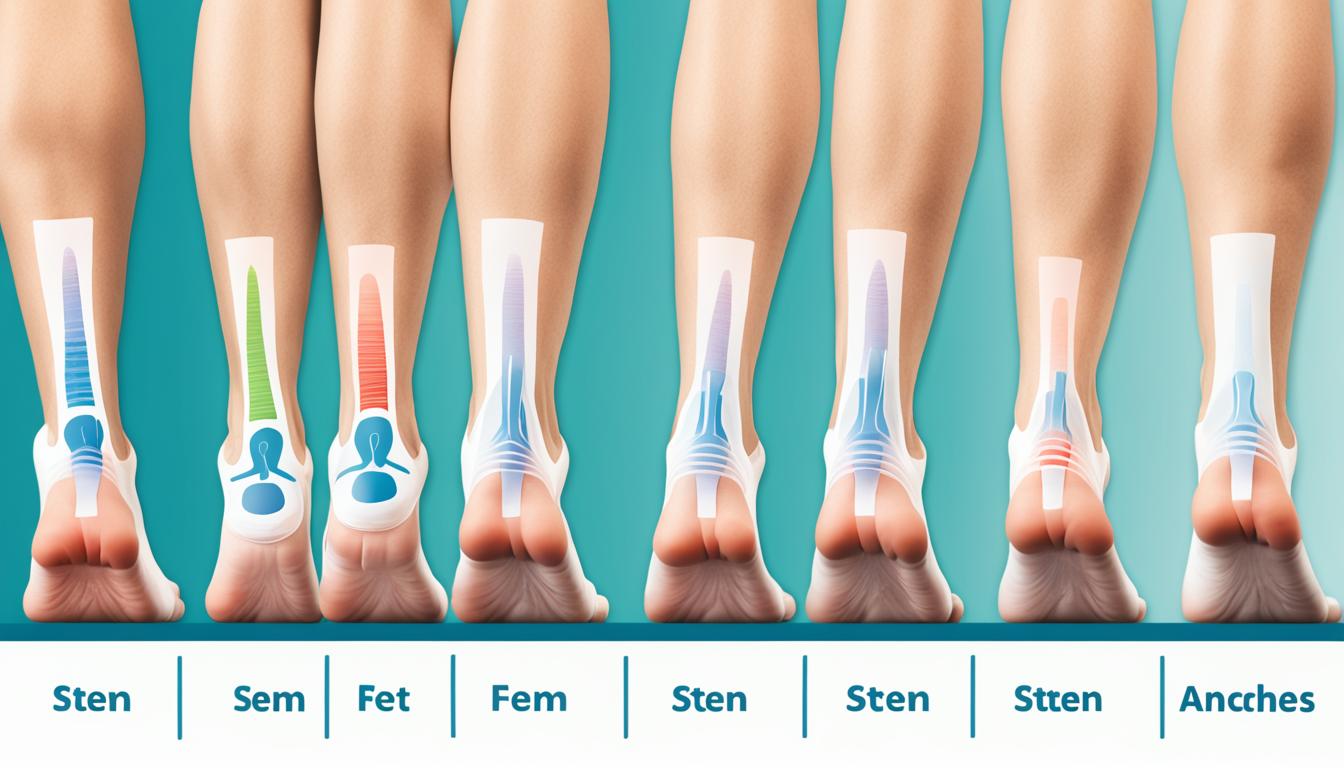Flatfoot is a condition where the foot arch either partly or fully collapses. It’s also known as fallen arches or flatfoot. This situation can cause discomfort, such as the toes drifting, the heels tilting, and the ankles turning. The most typical form is flexible flatfoot, often starting in childhood or teenage years. It gets worse as adulthood comes. In this type, the arch looks fine when no weight is on it. But, it falls flat when there’s pressure, leading to issues and pains.
This foot condition could also bring about bunions and hammertoes, making foot health and movement worse. Knowing the signs, reasons, and how to treat flatfoot is crucial. This helps in handling the condition and avoiding more troubles.
Key Takeaways:
- Flatfoot is a complex disorder that involves the collapse of the foot arch.
- Symptoms of flatfoot include toe drift, heel tilting, and ankle turning.
- Flexible flatfoot is the most common type and often begins in childhood or adolescence.
- Flatfoot can lead to other conditions such as bunions and hammertoes.
- Early diagnosis and appropriate treatment are essential for managing flatfoot effectively.
Types and Causes of Flatfeet
Flatfeet, or fallen arches, are sometimes passed down from family. Muscular imbalances can also cause them. And, injuries or fractures might make flatfeet worse.
Doctors diagnose flatfeet with a detailed exam. They study how someone walks and how flexible their feet are. They might use X-rays or other scans to look closely at the feet’s structure.
For treatment, doctors can suggest adding support. Orthotic shoe inserts or arch supports often help. They can make your feet feel and work better. Exercise and choosing the right shoes can also be big steps in managing flatfeet.
Working with a physical therapist can do wonders. They’ll help you do exercises that make your feet and ankles stronger. And by seeing a pro, you can get a routine that’s just for you.
Arch supports can be great for added support. They make sure your weight is spread evenly. But make sure to get the right ones for you by talking to a specialist.
Benefits of Flatfoot Treatment:
- Reduced foot pain and discomfort
- Improved foot function and stability
- Prevention of further foot complications, such as bunions and hammertoes
- Enhanced mobility and ability to participate in physical activities
With the right care for flatfeet, you can see a big change. There will be less pain and your feet will work better. A foot health pro can help you craft a plan that fits you just right.
Surgical Options and Innovations in Flatfoot Correction
Severe flatfoot cases might need surgery, mainly for kids older than 8. Doctors can use various methods to fix flatfoot. They might do tendon transfers, osteotomies, or fusions.
These surgeries work to solve the main problems of flatfoot. They aim to get the foot back to its correct position and improve how it works.
New medical tech offers less invasive options. PRP and stem cell treatments are showing great results. They can heal, lower pain, and make the foot work better.
In PRP therapy, blood with high platelet content is taken from the patient. This blood is then used for injections. These injections can reduce pain, start healing, and boost foot health.
Stem cell therapy uses the patient’s own or donor stem cells. These cells turn into different cell types. They can help fix and grow new foot structure cells.
After treatment, regular check-ups are key to success. They let the doctor see progress and make changes to the treatment if needed. Taking care of your feet is also vital. This means good hygiene and wearing right shoes.
By using both surgery and new treatments like PRP and stem cells, flatfoot patients can find real pain relief and better foot health.
Innovations in Flatfoot Correction
| Surgical Options | Advantages |
|---|---|
| Tendon transfers | Realigns foot structures and restores function |
| Osteotomies | Corrects bone deformities and improves foot alignment |
| Fusions | Stabilizes and supports the foot arch |
| Platelet-rich plasma (PRP) injections | Stimulates tissue repair and regeneration |
| Stem cell treatments | Promotes natural healing and tissue regeneration |
Conclusion
Fixing flatfoot requires deep understanding, correct diagnosis, and specific treatments. Both non-surgical and surgical ways help deal with it.
New methods like minimally invasive surgery and regenerative medicine offer hope. For example, stem cell therapy might help those with flatfoot.
But, it’s important to keep up with aftercare and look after your feet as a whole. Regular check-ups, good hygiene, and picking the right shoes help a lot. They keep your feet healthy and prevent future issues.
If you think you have flatfoot, see a doctor for a check-up and a plan made just for you. Remember, finding it early and taking action is vital for treatment.

